Gróf Degenfeld Winery
by
Terry Sullivan
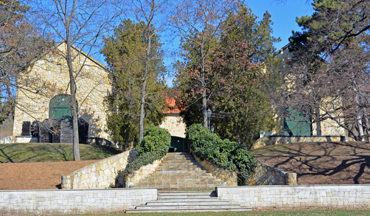 Summary: On the outskirts of the town of Tarcal in the Tokaj wine region, lies the wine estate of Gróf Degenfeld. Turning off the road onto the estate, the first building is the hotel. This hotel is a wonderful base for exploring wineries throughout Tokaj. Beyond the hotel there are vineyards that make for nice ambled walks. The winery complex is in the vineyards behind the hotel.
Summary: On the outskirts of the town of Tarcal in the Tokaj wine region, lies the wine estate of Gróf Degenfeld. Turning off the road onto the estate, the first building is the hotel. This hotel is a wonderful base for exploring wineries throughout Tokaj. Beyond the hotel there are vineyards that make for nice ambled walks. The winery complex is in the vineyards behind the hotel.
The Count Degenfeld family was of German and Swiss descent who came to Hungary in the 1800s. Winemaking was part of this family tradition for generations. During the Communist times, the family lost their property. In 1995, after the Communist reign, they purchased 100 hectares (247 acres) of land on the edge of Tarcal. The land already had vineyards planted, a cellar and a viticulture school. The school is now the hotel.
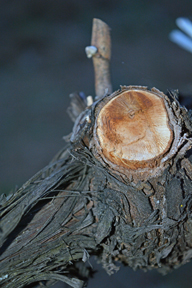 Vineyards
Vineyards
Of the 100 hectare estate, 35 hectares (86.5 acres) are under vine. Planted are the three traditional Tokaj grapes including Furmint, Hárslevelü and Sárga Muskotály (Muscat Blanc à Petits Grains). There are also plantings of Zéta, Kabar and Kövérszőlő. The vineyards are organically farmed and have been certified organic since 2012. Since 2018, the wines have also been certified organic.
During our mid-March visit, the vines were just beginning to awaken from their winter’s slumber. Buds were beginning to push forward. When visiting during this time of the year, one can observe the vine’s elegant architecture.
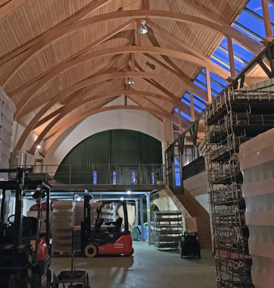 Winery and Cellar
Winery and Cellar
The tour of the winery and cellar was conducted by our Tokaj guide, Gergely Somogyi. Gergely spent some time conducting tours and tastings here at Gróf Degenfeld. The winery production facility is in a large building with a beautiful honey-colored wooden ceiling. Large wooden arches support this ceiling that has a bank of windows on one side.
Before to entering the cellar, Gergely stopped in a room to show us several artifacts and photos on the walls. A particularly interesting photo showed a grape cluster with the majority of the grapes botrytized. The shriveled grapes were affected by the fungus Botrytis cinerea also known as Noble Rot. These are the grapes that are used to make Szamorodni and Aszú wines at Gróf Dengenfeld. Prior to testing for the residual sugar levels in these sweet wines, winemakers, at one time, used puttonyos of botrytized grapes added to the must. We saw a puttony, a wooden container that botrytized grapes were added to and worn on the worker’s back from the vineyard to the winery. To craft an Aszú wine, five or six of the puttonyos were added to the must in a 136-liter barrel. Out of tradition, wine labels will still indicate the word puttonyos and the number 5 or 6; with 6 puttonyos indicating the sweeter Aszú wine.
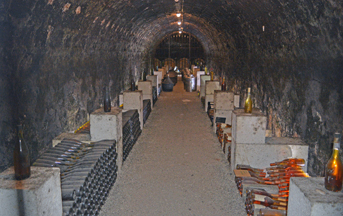 Gergely led us into the cellars. Black moss covers the walls of the cellar. This moss acts as a humidifier absorbing water in high humidity and releasing water in low humidity. In addition to viewing barrels, wine bottles were stacked laying on their sides. The Aszú wines cast an orange beacon in the subdued lighting of the cellar.
Gergely led us into the cellars. Black moss covers the walls of the cellar. This moss acts as a humidifier absorbing water in high humidity and releasing water in low humidity. In addition to viewing barrels, wine bottles were stacked laying on their sides. The Aszú wines cast an orange beacon in the subdued lighting of the cellar.
Wines
Gergely conducted our wine tasting during a multi-course dinner in the hotel’s restaurant. Our wine tasting began with a 2018 Hárslevelü. This wine was certified organic and had a light yellow color. Green apple and citrus were on the aroma and taste. The finish was crisp and had a long fruity aftertaste. The wine was paired with Duck Breast Carpaccio.
Our second wine was the 2016 Szamorodni with 127 g/L of residual sugar, 7.8 g/L of acidity and 10% alcohol. The yellow colored wine had jammy fruits and flowers on the aroma. The taste was reminiscent of apricot and pear jams. The mouthfeel was very smooth. The wine had a pleasant aftertaste. This wine was matched with Roasted Goose Liver. This pairing was wonderful. The dish had a slice of sponge cake on the plate with a layer of apricot, mango and chili jam over it. Atop the jam was the goose liver. The apricot notes from the wine played well with the apricot notes of the dish.
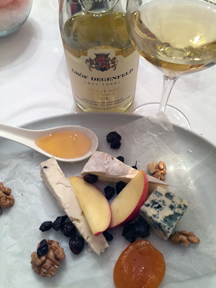 The 2017 Muscat Blanc had a straw color. It had 12.7 g/L residual sugar. The aroma was floral reminding one of walking through a flower garden on a spring day. The taste was delicate with a hint of orange blossoms. The finish was fresh and crispy. This wine was paired with zander (fish) roasted on its skin and served with arugula risotto. The delicacy of the wine and zander matched.
The 2017 Muscat Blanc had a straw color. It had 12.7 g/L residual sugar. The aroma was floral reminding one of walking through a flower garden on a spring day. The taste was delicate with a hint of orange blossoms. The finish was fresh and crispy. This wine was paired with zander (fish) roasted on its skin and served with arugula risotto. The delicacy of the wine and zander matched.
The 2014 5 Puttonyos Aszú had a light gold color. The wine was aged in wood barrels for 18 months. It had 172 g/L of residual sugar, 8.2 g/L acidity and 11.5% alcohol. Dried fruits and flowers were on the aroma. The taste offered apricots and honeysuckle. The wine had a silky mouthfeel. The wine was paired with cheeses, dried fruits such as apricots and apple slices.
The elegant evening dinner and wines offered a wonderful gastronomic experience.
The Gróf Degenfeld estate winery offers wine enthusiasts beautiful vineyard views, a winery that combines the new with the old and a hotel with elegant dining.
Article about Gróf Degenfeld Castle Hotel
Gróf Degenfeld Winery
H-3915 Tarcal, Terézia kert 9 Hungary
Article written April 2019.
Please support the following Hungarian wineries and wine tour company.
| Wine a'More Travel |



